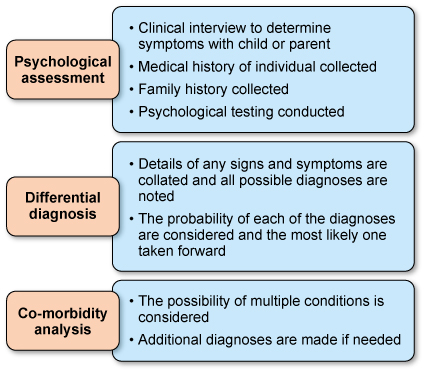1.3.3 The diagnostic process
Diagnosing any condition does not simply require identification of symptoms. The whole process of diagnosis is complex and will often begin with a trip to see a GP, who may make a referral to a specialist. In the case of ADHD, the type of specialist someone is referred to depends on their age and the services available locally. This means that some people will be referred to a psychiatrist while others may see a learning disability specialist. When a specialist sees an individual, they will then work through a series of steps to establish a diagnosis as you will see in Activity 3.
Activity 3 Diagnosing ADHD
The diagnostic process includes several different stages as shown in Figure 4.
Watch Video 3 How is ADHD diagnosed [Tip: hold Ctrl and click a link to open it in a new tab. (Hide tip)] in which Thomas E Brown briefly discusses the difficulty in diagnosing ADHD. As you watch the video make notes of the challenges he mentions. You may like to use the box provided.
Discussion
Dr Brown notes that there is no one test to determine ADHD. No medical imaging of the brain, no blood test, no EEG, no computer test. Clinical interview is used where a medical professional who understands ADHD obtains a variety of information from various sources e.g. the child, the parents, teachers. The aim is to understand functioning at school and home. Focus questions are: What is life like? What stressors are there in life? Any other health problems? Is there any known family history of ADHD?
You saw in Section 1.1 that variation in prevalence is found according to culture and gender. The next section will explore briefly how these factors impact on diagnosis.

